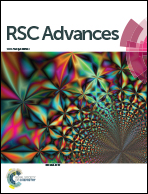De novo synthesis of novel bacteriogenic nanocell particles and its cancer cell compatibility evaluation†
Abstract
This study demonstrates the effective synthesis of nanocell particles of bacterial origin using an eco-friendly ultrasonic approach. The synthesized particles were separated by sequential centrifugation. The probe sonication technique with 5 min sonication time at 20 kHz frequency successfully yielded regular spherical shaped organic nanoparticles directly from bacterial biomass in the 33–42 nm size range. The holding capacity of the particles was verified by synthesizing the particles in the presence of acridine orange (AO) and further characterized using FTIR and fluorescence spectroscopy. The internalization ability of all the three different sized particles separated after sonication by differential centrifugation was elaborately investigated on HeLa cells using confocal laser scanning microscopy. Out of the three different particles tested, the nanosized particles exhibited maximum internalization capacity. The toxicity/biocompatibility on HeLa cancer cells was studied using MTT assay and the results substantiated that all the particles were highly biocompatible. The results confirm that the indigenously synthesized nanocell particles can be used as efficient drug carriers for drug delivery for cancer cells.


 Please wait while we load your content...
Please wait while we load your content...